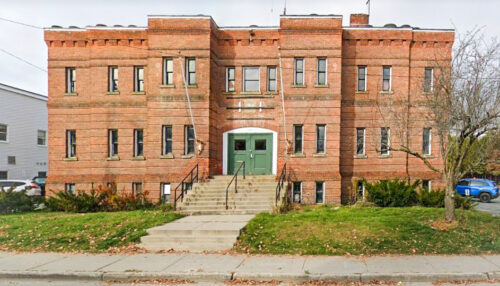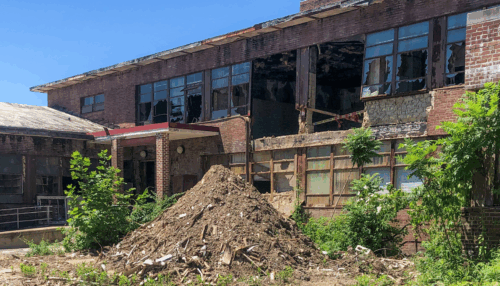
CASE STUDY
Contaminated Land to Community Sports Complex: The Chase Fieldhouse Project
The South Garaches Lane site in Wilmington, Delaware, has a long and varied history, reflecting decades of industrial use as a railroad easement and multiple auto salvage yards dating back to the 1940s. Over time, these activities led to environmental concerns, including elevated levels of heavy metals, polycyclic aromatic hydrocarbons (PAHs), and polychlorinated biphenyls (PCBs) in the soil and groundwater—levels that exceeded safety standards established by the Delaware Department of Natural Resources and Environmental Control (DNREC).
Recognizing the potential to transform the site into a valuable community asset, Montrose was brought in to assess the degree and extent of contamination in the future outdoor sports fields and roadways areas and develop a thoughtful, science-based remediation plan. Another environmental consultant, Brightfields, was involved in the early stages of the project, specifically addressing the future field house building area. Meanwhile, Alliance was assigned to investigate and remediate the outdoor sports fields, roads, and parking lots. The goal: to pave the way for a safe, vibrant new sports complex that will serve the Wilmington community for years to come.
Assessing the Site’s Challenges
The area assigned to Montrose consisted of five Hazardous Substance Cleanup Act (HSCA) sites, some of which had not previously been investigated. After establishing the project scope, Montrose performed extensive sampling of soil and groundwater to assess the site’s condition. Results showed wide-ranging contamination that surpassed DNREC’s soil standards for commercial use. Elevated levels of arsenic, lead, iron, manganese, zinc, and organic contaminants posed potentially significant hazards to local communities and ecosystems. Additionally, the soil contained unwanted materials such as car parts, crushed brick, glass, wood, and cinders, complicating remediation efforts. A Human Health Risk Assessment indicated risks for both residential and groundwater receptors before development, necessitating an efficient intervention.
A Comprehensive Remediation Strategy
Montrose employed a systematic approach beginning with a tailored Remedial Action Work Plan (RAWP), which received DNREC’s rigorous review and approval. This plan was based on technical expertise and innovative methodologies for thorough assessment and cleanup. A site-specific Health & Safety Plan and Contaminated Materials Management Plan (CMMP) were also developed and implemented.
Initially, monitoring wells, test pits, and soil borings were strategically installed to measure contamination extent. Laboratory analyses and risk assessments shaped a remediation strategy that included multiple operable units (OUs) across the site. Key components included active management of dewatering, safe disposal of contaminated materials, and ongoing Health & Safety monitoring during construction.
Collaborative efforts were critical to success. Continuous communication with DNREC project officers, supervising engineers, and construction managers facilitated proactive management of excavated soils and adherence to environmental regulations. The remediation solution involved capping contaminated areas with DNREC-approved materials and implementing an Environmental Covenant to prohibit groundwater usage, minimizing future risks.
The People Behind the Project
Our dedicated team of environmental engineers, project managers, field staff, and health and safety specialists were advocates for environmental stewardship throughout the process. Regular planning meetings included the client, DNREC, construction managers, and the Project Engineer which fostered collaboration among stakeholders, allowing us to swiftly address challenges, including responding to emergencies involving construction equipment and managing the disposal of hazardous materials.
Project Outcome: A Community Asset
The transformation of the South Garaches Lane site led to the Chase Fieldhouse, a state-of-the-art sports complex that houses the Delaware Blue Coats NBA G-League basketball team and the Titus Sports Academy. With both indoor and outdoor sports facilities, the complex enhances the Wilmington Riverfront area and serves as a valuable local resource.
By turning contaminated land into a vibrant community hub, the Chase Fieldhouse exemplifies sustainable redevelopment and demonstrates how proactive environmental management can lead to positive community outcomes.
Key Stats
- DNREC Criteria Fully Met: Remediation efforts satisfied all regulatory standards, ensuring the site is safe and ready for community-focused redevelopment.
- 5,000+ Cubic Yards of Soil Removed: Contaminated soil safely excavated and relocated or disposed of in full compliance with environmental regulations.
- Extensive dewatering: Managed hundreds of thousands of gallons of impacted groundwater with monitoring and full compliance under a municipal permit.
- New Standard for Groundwater Protections: Access restrictions implemented to protect local ecosystems and public health, setting a precedent for future redevelopment projects.
- Continuing Long-Term Stewardship: Performing annual LTS inspections for the client to ensure compliance.
Related Content
Explore more of our successful remediation and transformation projects that emphasize the importance of environmental management and community revitalization.




